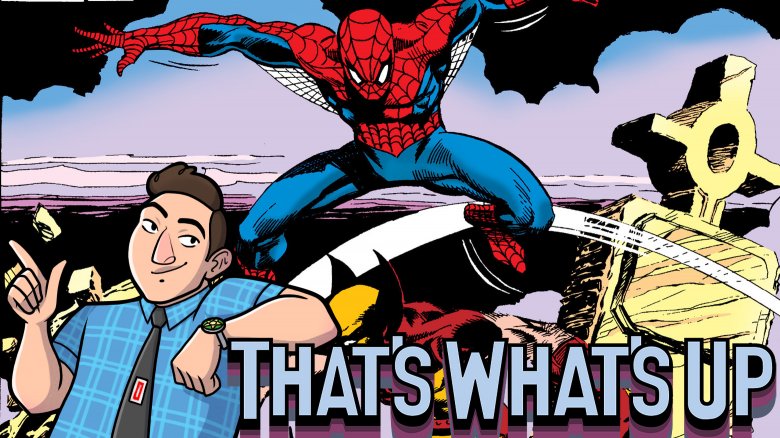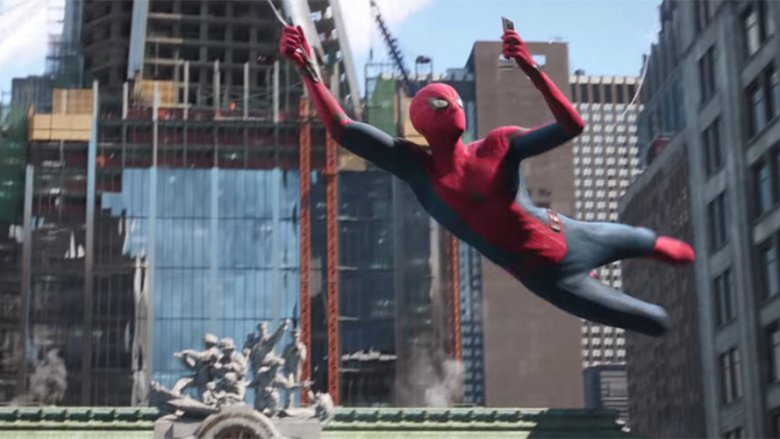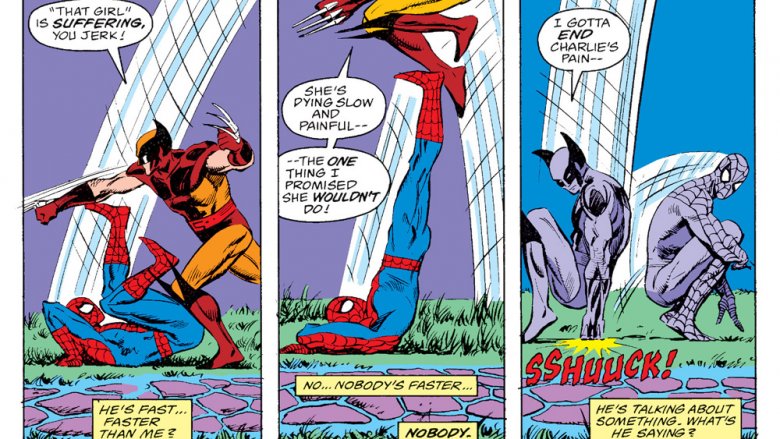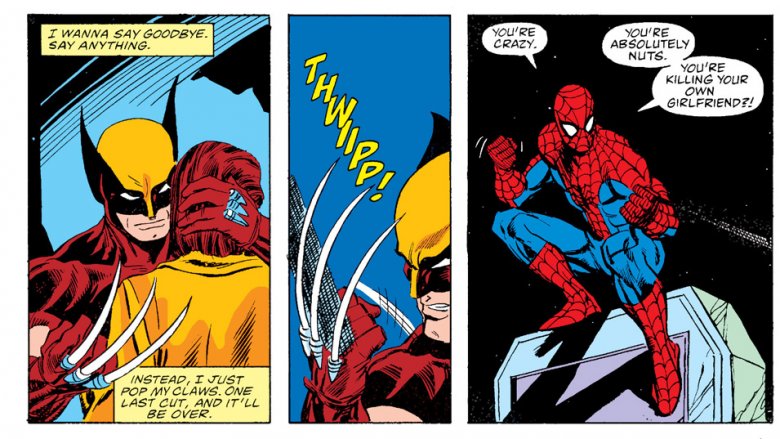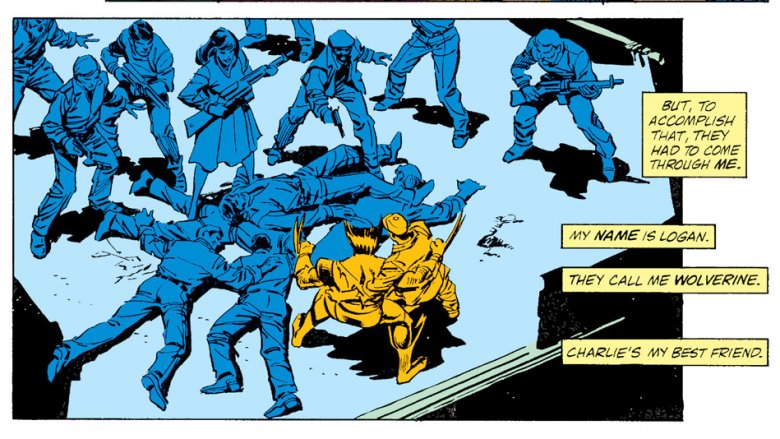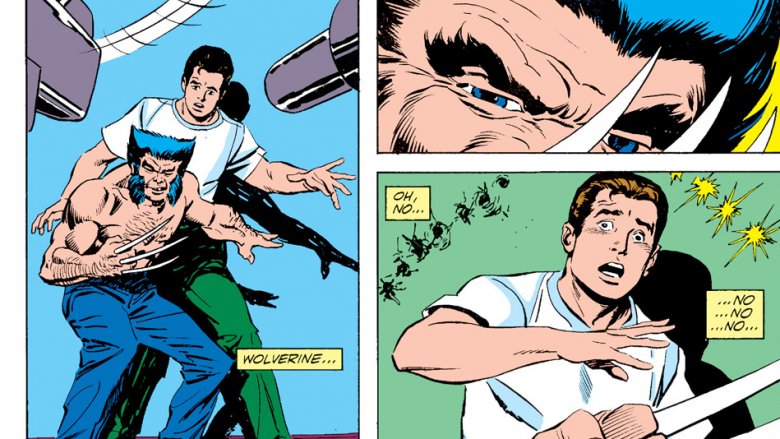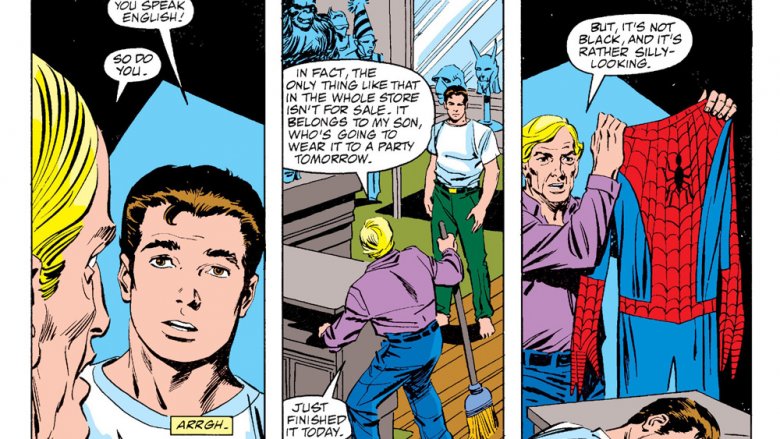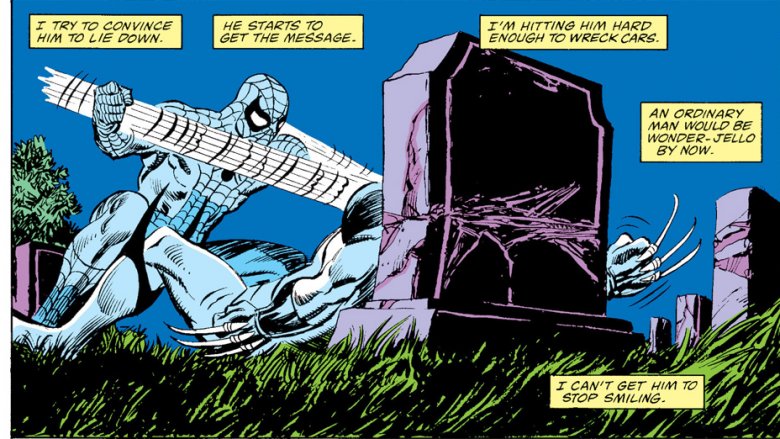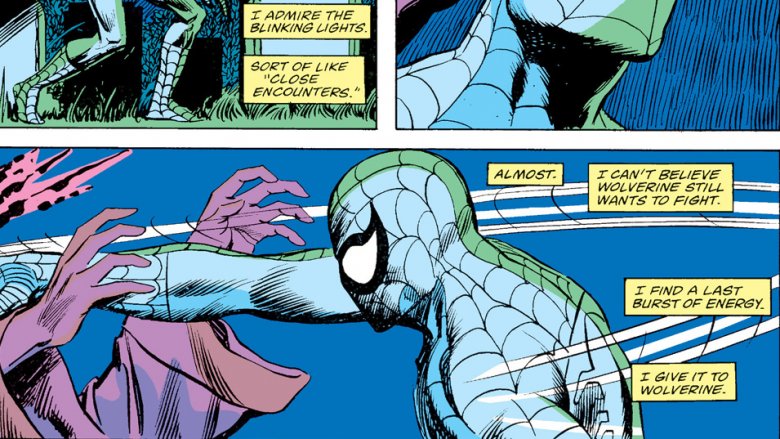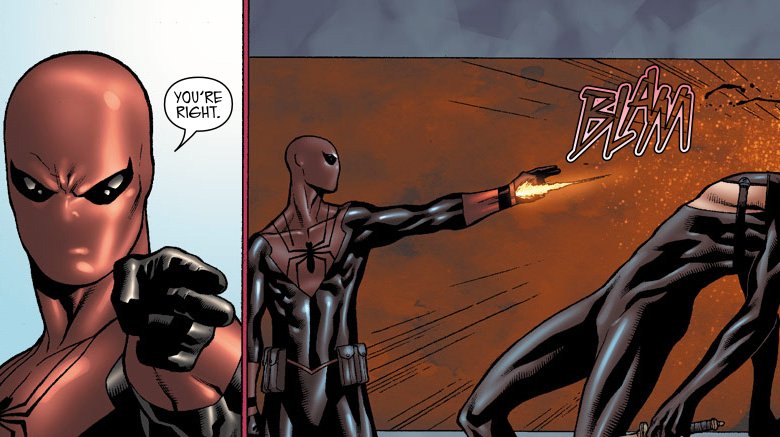That's What's Up: The Last Time Spider-Man Went To Europe He Accidentally Punched Wolverine's Ex-Girlfriend To Death
Each week, comic book writer Chris Sims answers the burning questions you have about the world of comics and pop culture: what's up with that? If you'd like to ask Chris a question, please send it to @theisb on Twitter with the hashtag #WhatsUpChris, or email it to staff@looper.com with the subject line "That's What's Up."
Q: You've said before that Homecoming was your favorite MCU movie. Thoughts on the new trailer for Spider-Man: Far From Home? — via email
Friends, I am excited about that new Spider-Man movie. I mean, you're right, with as much as I loved Homecoming, I was bound to be excited about it anyway, but I was not prepared for the pure delight I felt when I watched that trailer. Aunt May being supportive of Peter's heroism! Mysterio in his his dang bubble helmet! The incredibly important reveal that Spider-Man's birthday is two days away from mine! There's so much to look forward to!
That said, there was one other thing that raised my eyebrows about the trailer. When they announced that the title would be Far From Home, I kind of assumed that they meant that either metaphorically, or that it was going to somehow tie in to Peter going all the way out into space (and dying) in Infinity War. Instead, it turns out that they're taking Spidey out of New York and into Europe, and that's a really interesting choice.
I mean, the last time Spider-Man went to Europe, he accidentally punched Wolverine's ex-girlfriend to death.
Spider-Manhattan
You don't often see Spider-Man stories that take him out of New York, and there's a really good reason for that. More than any other character, Spider-Man is tied to NYC — and specifically to Manhattan, even if he's originally from Queens — in a very tangible way.
The only other character who's as closely identified with a setting is, of course, Batman, but Gotham City has the luxury of being a fictional city that was built for the character, rather than the other way around. All those gothic gargoyles and imposing Art Deco towers, the fact that it's apparently midnight for 23 hours a day and the sky never gets lighter than blood red, that's all stuff that comes as an extension of having a character who is, by his very nature, nocturnal and spooky. Spider-Man, however, is informed by something real that exists in our world, and when you start thinking about it, that's pretty cool.
He is, in every way, a superhero built for a city of skyscrapers. He needs walls to crawl on and buildings to swing from, and the towering buildings of Manhattan are pretty much just the idea of walls taken to their most superheroic extreme. There's a verticality that's necessary for Spider-Man to work, to the point where he's the kind of character that could only be created by people who were working in that place and were able to see how twisting those dizzying heights and narrow concrete canyons could turn any fight into a high-octane dramatic set piece. As strong as he is, as high as he can jump, Spidey just doesn't feel the same if you drop him into an empty field. That's why he so rarely leaves the city, and, incidentally, why some of the best art to ever hit a Spider-Man story comes from Paolo Rivera, who would draw entire action scenes where Peter Parker was never, ever standing on the ground. It's all walls, ceilings, and webs, and that's the way it should be.
Oh, right. Killing Wolverine's girlfriend. I should probably get back to that.
Thwip vs. Snikt
It happened back in 1987, in an oversized one-shot that was called, appropriately enough, Spider-Man vs. Wolverine, and when I saw Spider-Man hanging around Venice and London, it was the first thing that came to mind. Not because I expect anything that happens in this comic to make it to the screen, but because it's one of the most memorable Spider-Man stories of all time — and one of the most memorable Wolverine stories, too.
For one thing, it's one of the first times that Spider-Man and Wolverine really interact with each other on a one-to-one basis. Spidey, of course, was no stranger to team-ups, but this particular story came right as Wolverine in his ascendency as a solo character. While he'd already starred in the famously rad solo miniseries by Chris Claremont and Frank Miller by this point (and had completed his transition from ensemble player to full-on star in the pages of Uncanny X-Men), this was a year before Marvel would decide that he could hold down his own monthly series.
If I had to guess, I'd say that this particular story was done as a sort of proof-of-concept pilot for the Wolverine series. They were testing the waters to make sure readers were still interested in seeing him on his own, with Spider-Man there as the established character to pull in readers, just in case they aren't. Spoiler warning: readers were absolutely interested in seeing a truly ridiculous amount of Wolverine, and they got their wish once the '90s rolled around.
Claws ain't webs, bub
At heart, Spider-Man vs. Wolverine is a story about taking Spider-Man out of his element and putting him into Wolverine's, illustrating how different they are as characters. And, because this is a superhero comic we're talking about, Christopher Priest and Mark Bright — a truly killer team that consists of the writer who redefined Black Panther and created the Dora Milaje and the artist who drew the iconic image of Cobra Commander kicking a puppy in G.I. Joe #100 — have the luxury of being able to take all of these metaphors and make them extremely, devastatingly literal.
To that end, while Spidey gets top billing, they actually open up the story with Wolverine, setting up everything that readers had come to expect from a story focused on Logan. There's international intrigue, moral ambiguity, and another piece of his dark past working as a government agent — all things that fit perfectly with the X-Men's resident man of mystery, but that generally aren't what pops up in the pages of Amazing Spider-Man.
Oh, and there's one more signature element of Wolverine stories that makes an appearance right off the bat in this one: Death. Lots and lots of death.
Death and the Spider-Man
Wolverine is a killer. There's really no getting around that when your defining visual characteristic is that you've got six gigantic knives sticking out of your fists, but it has a particular emphasis on this story and how it relates to Spidey. Going back to that classic Claremont/Miller story, Wolverine kills something like 900 ninjas in that thing. Admittedly, there are a lot of narrative gymnastics in there to get around the Comics Code — the Hand's ninja soldiers are weird reanimated corpses who dissolve into smoke when they're "killed," making them the perfect faceless enemy for Wolverine to carve his way through while an internal monologue talks about how they didn't make him an animal... they just gave him claws. At the end of the day, though, Logan has no problem killing to survive.
Spider-Man, on the other hand, Does Not Kill, in capital letters. It's one of his defining characteristics, to the point where there was a long-running plot point a few years back when he obsessed over the idea that "while I'm around, no one dies." Heck, in 2018's Amazing Spider-Man #800, Pete took a bullet for Norman Osborn, of all people — and Osborn was also Carnage at the same time! He's the Friendly Neighborhood hero, and the tragedy of his origin drives him to stave off death for as long as possible. He fights it, and he wins... except when he doesn't.
That's the brilliance of how Priest and Bright start this story. The opening flashback doesn't just introduce Wolverine's relationship with Charlie — aka Charlemagne, the pseudonymous secret agent that Wolvie worked with back in the day — it establishes their relationship with death. It's an inevitability, and the only question is how it comes, and whether you're able to greet it on your own terms. So, you know, that's the story that Spider-Man literally swings into on page 6.
We all got problems
At the time of this story, Peter's in one of his occasional "must there be a Spider-Man?!" moods. He fails to stop a couple of murders, things are going bad with Mary Jane, and he just wants to take a break from everything. Fortunately, J. Jonah Jameson's got a clutch assignment for him — heading to Berlin to help reporter (and prime Hobgoblin secret identity suspect) Ned Leeds track down a mysterious cold war assassin who has resurfaced and is taking out former clients. Code name: Charlemagne.
Wolverine is also looking for Charlie because he knows she needs help. The KGB and the CIA are after her, too, and she's called in a favor that Wolverine has to honor. He passes by Peter on the street and recognizes him by scent from back when they were hanging out in space during Secret Wars. Even though Peter's there specifically to get away from being Spider-Man, the fact that he's there in Berlin and he's inexperienced with this spy stuff and/or stupid enough to be talking about tracking down this assassin, by name, in the middle of the street makes Wolverine think he's there to get involved in a more active capacity than just taking pictures.
That's what pulls Spider-Man into Wolverine's world. That's why he's not there when Ned gets his throat cut, which is why he's too shocked to move when he's ambushed by a quartet of spies, and why Wolverine has to be the one to save him by killing them all right in front of them. And then things get immeasurably worse.
Die Spinne
That doesn't mean that it's all doom and gloom, though. As much as this is a story set in Wolverine's world, it's still a Spider-Man story, and that means it still has the humor that you want out of a Spider-Man story. The prime example? Peter leaves his costume back in New York (although he accidentally brings a set of web-shooters with him, because he's just not Spider-man without the swinging), so he goes to a costume shop in Berlin to buy a new one.
This was back when Spidey was still wearing the black costume, but the shop is out of bodysuits and masks. Fortunately (or un, depending on how you look at it), the costume shop has exactly one custom job that'll fit the bill: a red-and-blue Spider-Man costume. The punchline? As much as it might look like Spider-Man's genuine suit, it's basically just a Halloween costume. And, like, all Halloween costumes from the '80s, it's not quite accurate, and instead has "DIE SPINNE" (German for "The Spider") written on the back in big letters.
I'm pretty sure this was the inspiration for the amazing recent comics where Blade (you know, the vampire killer) was protecting his identity by wearing a bright purple and green knockoff "Spider-Hero" costume. It's pretty great here, though, and if you want to really add some gallows humor to the whole story, keep in mind that when that ending hits, the whole thing is happening while Spidey is wearing a bootleg knockoff of his own costume with the wrong name written on the back.
I'm hitting him hard enough to wreck cars
Eventually, Charlie's identity is revealed to the reader: not the man that Ned Leeds suspected, but a woman whose history with Wolverine goes beyond just a working relationship. They're former lovers, and, as Wolverine says in the comic, "my best friend," giving the debt of honor stuff that's established earlier a whole new context.
Much like Wolverine, though, Charlie has made plenty of enemies in her career freelancing for the KGB, the CIA, and whoever else can meet her fee, and she doesn't have the benefit of an adamantium skeleton and a healing factor. She's been marked for death by pretty much everyone, but she doesn't want to spend the rest of her life on the run, always looking over her shoulder until someone finally catches up to her. Now that she's tied up the loose ends of former clients who tried to betray her, she leads Wolverine to a cemetery and asks him to kill her, trusting her best and only friend, someone she loves, with allowing her to die on her own terms. It's something Wolverine understands.
Spider-Man, however, does not. Without the context for what's going on, he arrives just in time to see Wolverine pop his claws into what he thinks is Wolvie's girlfriend — and Charlie's still alive afterwards, because even though he understands, the act of having to kill someone he loves is the only time in the entire story that Wolverine flinches, missing the fatal strike before steeling himself to finish the job. He doesn't get the chance. Instead, Spider-Man decides that this is one murder too many, and goes buck wild on Wolverine, beating the living bejeezus out of the X-Man.
One thing I really like about Spider-Man is that he's always holding back when he's fighting crooks, but he's also strong enough to bench press a pickup truck. With Wolverine, the unbreakable bones and healing factor mean there's no reason for him to hold back his anger, and in one of Bright's career-best pages, he throws Wolverine against a tombstone and then punches him again and again, so hard that the thick stone shatters behind Wolvie's head.
The punch
At the end of the fight, Spider-Man realizes that the only way he's going to be able to stop Wolverine is to kill him, and chooses instead to walk away, leaving this awful world of moral ambiguity behind as a group of spies show up to finish Charlie off. Wolverine berates him for messing things up, because now instead of the quick, clean finish that she wanted, Charlie's in danger of being captured and dying much, much slower. Spidey's done, though, but as he turns to walk off, Wolverine grabs him by the shoulder, and Spidey's so angry, disgusted, and exhausted by the whole thing that he just turns around and punches him with every ounce of strength that he has.
Except... it's not Wolverine. It's Charlie. Charlie, who has no super-powers, no adamantium skeleton, no healing factor. Rather than being taken alive, she uses Spider-Man as a tool to commit suicide. It works, too. After being clocked by the proportionate strength of a spider, she lives just long enough to tell Wolverine that she got what she wanted: to choose her death rather than to have someone choose it for her. To this day, she's the only character that Spider-Man has ever killed — and even though it's Charlie doing it to herself, its impact on Peter Parker has all the guilt that you'd expect from a Spider-Man story.
The panel where Spidey hits her is brutal by design, not just in the moment itself, but because it's repeated for the remainder of the story. Every time Spider-Man has a moment with his thoughts, Bright drops that same panel, with the colors washed out to a vivid red, onto the page. It happens when he's at the airport, when he gets home and sees his costume. It's a great visual representation of how those traumatic moments show up uninvited in your mind, as fresh as the second they happened.
What If...?
If you do want to get another piece of this particular story, it's worth checking out What If: Spider-Man vs. Wolverine, by Jeff Parker, Paul Tobin, and Clayton Henry. Released in 2008, it takes a look on what would've happened if Spider-Man had decided to deal with the trauma of Charlie's death by embracing the world of covert ops. Over the course of the story, he becomes, uh, amazing and spectacular at government-sanctioned assassinations, and even reveals at one point that he's added wrist-mounted guns to his web-shooters. It's never mentioned in the script, but I really hope he calls them "bullet-shooters."
For the record, I don't actually think any of this has any bearing on what's going to happen in in Far From Home, if only because I'm pretty sure nobody really wants to see Tom Holland do an accidental murder/suicide while dressed as a cartoon character beloved by children. But, you know, it also looks like Hydro-Man is in a movie now, so who knows what's going to happen in these things?
Each week, comic book writer Chris Sims answers the burning questions you have about the world of comics and pop culture: what's up with that? If you'd like to ask Chris a question, please send it to @theisb on Twitter with the hashtag #WhatsUpChris, or email it to staff@looper.com with the subject line "That's What's Up."
